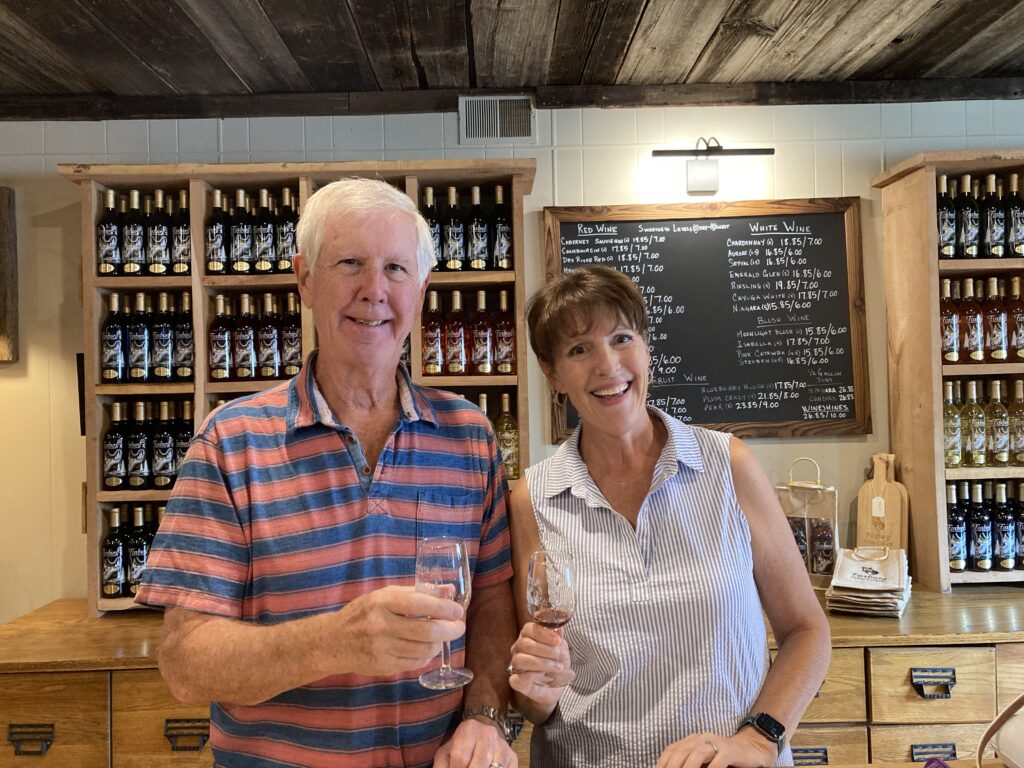
Sometimes a mediocre wine in the right setting just seems to work. Sure, I usually obsess about wine quality and pairings. But when it’s a perfect, cool evening (for the Texas crowd, by cool I mean in the low seventies) and you’re sitting on a riverbank watching kayaks paddle by, wine quality becomes a little less important to the overall experience. Add to that a wine made from an obscure grape and things can get downright interesting.
- The picture above is Jim and Marisa at the Foxburg Wine Cellars tasting room in Foxburg, Pennsylvania, a quaint little town overlooking the Allegheny River. The tasting room offers free samples of the winery’s thirty wines, as well as a nice outdoor patio where you can relax with some snacks and a glass of wine.
A quick quiz: what’s the fourth largest wine producing state? Yep, it’s Pennsylvania, which just edges out Oregon for number four. Didn’t see that one coming, did you? The state has five American Viticultural Areas (“AVAs”), three of which are shared with New York and Ohio. The most planted varieties are Cabernet Franc and Merlot, followed by hybrids Chambourcin and Vidal Blanc.
- Hybrid grapes are bred from two different species, typically a European and an American variety. They’re popular in Northeast U.S. states and Canada because they’re designed to withstand harsh conditions, such as high humidity and winter cold, that can kill many more traditional varieties.
One popular hybrid is the Marechal Foch. It was bred in Alsace from the European Goldriesling grape and an unknown American partner. Foxburg Wine Cellars refers to it as the “Pennsylvania Merlot,” which is a good marketing ploy for an unfamiliar grape, but it’s unlikely that anyone would confuse the two.
- For history buffs, the grape is named after French World War One general Ferdinand Foch, who was the Supreme Commander of the Allied forces.
Our featured wine is a Foxburg Wine Cellars Marechal Foch (about $20 retail). I didn’t list the vintage because, well, it doesn’t have one. We were told that the grapes were grown in the Lake Erie AVA in northwest Pennsylvania and vinified at the winery in Foxburg, but the label shows that it’s a Pennsylvania wine. Bottom line: the grapes can come from anywhere in Pennsylvania and be from any vintage. OK, so nothing’s perfect. The wine was fermented in plastic vessels using oak chips, an inexpensive alternative to oak barrels intended to impart oak flavors and aromas. Yep, nothing but the best here. But, our overall verdict was that the wine is kind of fun for a casual summer night.
- We’ll skip the more technical analysis and just mention that the wine had a noticeable sweetness and tasted a lot like Welch’s grape juice. But the point was to try a small local winery, and we had a good time with it.
- So, next time that you pass a local winery in an interesting location – give it a shot!
Cheers!
